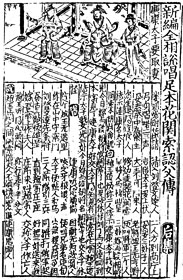Oral and Written Literature (5)
Oral-related texts
The oral medium is characterized by a high degree of flexibility, allowing the ‘same’ story to come out differently in every instance of repeated performance. The written medium, on the other hand, tends towards fixation of oral stories into singular versions with a more tight and ‘impeccable’ form, defined by the scribe or editor, rather than by the performer. In Chinese oral arts, the two activities of performing orally and committing oral stuff-material to paper seem but rarely to be undertaken by one and the same person. Even when it happens, there seems to be a vast difference between the two activities, each calling forth its specific framework and genre rules.
Some written sources stand in a particularly close relationship to oral performance traditions. Such texts are often called ‘oral-derived’. This term, however, implies a one-way derivation from orality to literacy. In Chinese culture we generally find that the influence between the oral and the written spheres is reciprocal. We shall call texts that exhibit this kind of relationship ‘performance texts’ or ‘oral-related texts’, leaving room for the possibility of influence in both directions.
The earliest anthology of poetry in China, the Book of Odes (Shijing), collected over time from around 1000-600 bc, apparently exhibits close ties to the milieu of oral folk song and ritual performance, thus fitting well with the idea of oral-related text, although knowledge about performance and professional entertainment in archaic China is scarce. Some of the oldest performance texts preserved are prosimetric texts from Tang and early Ming where the alternation between spoken and chanted passages is a predominant feature. These texts are particularly important for our understanding of the early performance practice of Chinese storytellers.
Next: The question of ’true orality’ in orally performed arts
